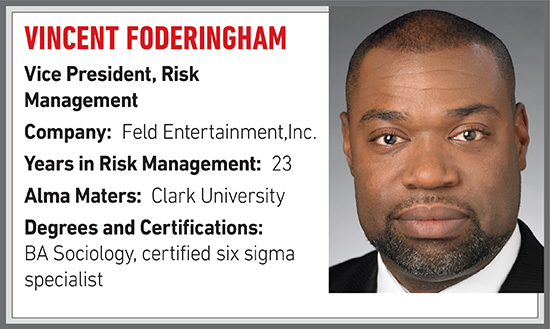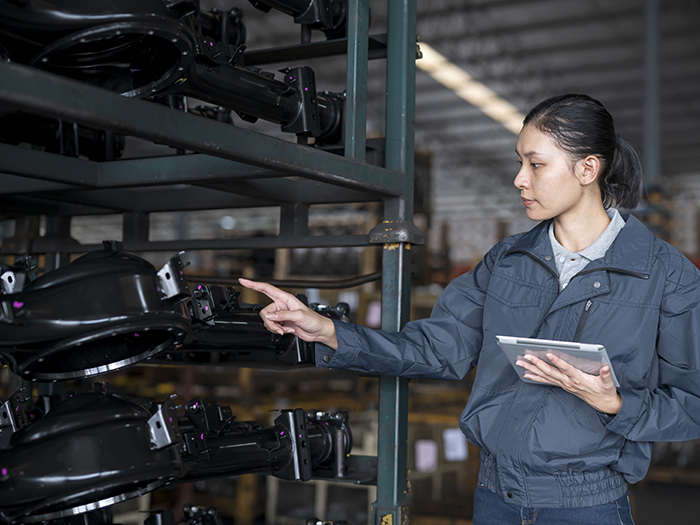How This Entertainment Risk Manager Sees the Future of the Industry from the Pandemic through Diversity and Inclusion Efforts

R&I: What was your first job?
I was a claims adjuster with Liberty Mutual. At Liberty Mutual, you trained across all lines of coverage. So, whether it was workers’ comp, personal or commercial auto, liability, homeowners — we did it all. We did our own investigations. We certainly settled our own claims.
We would travel around with checkbooks with a certain level of settlement authority. We were able to sit down with a homeowner or someone involved in a car accident with one of our insureds had the opportunity to offer money on the spot and settle the claim right then and there. Write a check, sign a release, and be done with the claim all at one time. That was back in the late 80s, early 90s. Things are a lot different now but that was my first job.
R&I: How did you come to work in risk management?
During my time with Liberty, I worked on claims for large deductible and self-insured accounts, particularly with retailers. I always developed good working relationships with the risk managers.
I often had side conversations with them to understand their roles, what they were doing, and at that particular time, I realized that I really wanted to be on that side of the business. I figured that whenever I had the first opportunity to do so, that I certainly would try to make the transition, and I wound up doing it.
My first risk management job was with a company called J. Baker, Inc. in Canton, Massachusetts. They were a huge retailer. They owned a number of apparel and shoe stores throughout the country.
Back then, it was Fayva Shoes, Parade of Shoes, and Casual Male, Big & Tall from the apparel side. They also did the shoe concessions and the number of different mid-tier department stores. I worked there for a couple of years and I knew at that particular point that was what I wanted to do.
I flipped back to claims for a couple of years with Sedgwick CMS, but then I had my first big risk management opportunity working for a very large defense contractor, and I wound up staying in risk management ever since then.
R&I: What’s been the biggest change in risk management and the insurance industry since you’ve been in it?
I would say that the first big change happened after 9/11. I was working for Raytheon Company, the defense contractor, at the time when 9/11 occurred.
I still remember that day, and not only was it impactful because I was working for a company that was in the defense business. Unfortunately, we had a number of people, and I had friends that were on all three planes. I also had friends that were in the towers that day, friends that I worked with and other business partners.
From a catastrophic perspective, nobody really understood or really would have understood the magnitude of a catastrophic loss of that size until it actually happened.
Now fast forward to today with COVID 19 and the pandemic risk. When you’re thinking about business continuity or enterprise risk management, you think about pandemic risk and what happened with SARS or other things, and you’ll say, ‘Oh geez, that’s never really going to happen,’ but here we are with COVID-19 and the pandemic risk is making that something very tangible and it’s changing everything on a global basis.
Look at how businesses have been impacted. Nobody thought that if you had a pandemic risk, that it would happen to this magnitude on a global basis.
One would think that with a pandemic risk that it might happen in pockets or in certain segments, but this pandemic risk has really affected everyone and everything. Nobody could have really foreseen the significance of its impact.
R&I: What’s the biggest challenge you’ve faced in your career?
It’s right now, I’m right in the thick of it. COVID-19 really has impacted our business significantly. It’s impacted the way we will go about doing business going forward.
Live entertainment is a huge challenge for us. Everything is so up in the air at this particular point for any business that’s trying to restart in the live entertainment sector. It’s very uncertain and until the virus gets under control, there isn’t a clear pathway back to some level of normalcy.
However, the good news is that we are seeing some stadiums and arena partners beginning to provide us with plans for sanitizing and percentages of capacity to achieve social distancing so we can start planning a restart our traveling tours.
We certainly look forward to getting our traveling tours back out on the road and being the bright spot during this difficult time.
R&I: How has the risk management and insurance space for live events and performances changed due to COVID-19?
This is going to be a significant challenge. We have resumption planning in place right now that documents our process and protocol around COVID testing for our employees as they begin to travel again. We must be mindful of the challenges that they face as they travel and we are providing specific recommendations and guidance for their well being and safety.
Fortunately, our process has been trialed and tested as we completed the last seven rounds of Monster Energy Supercross in Salt Lake City back in June and it worked very well.
With our touring model, we have a large number of people that will travel together in groups. Our challenge is keeping all of them safe.
Is it okay for them to go to restaurants? What are the activities for them that would be safe?
The answer to those questions might be that there really isn’t any activity that could be safe for them. So, we have to put together specific guidance to help minimize any risk of COVID exposure. The world isn’t the same as it was before and there are no guarantees but we must try our best to keep our people as safe as possible.
However, there has to be a shift of how people view what they can or what they should do, as compared to the risks they face if they continue to operate as they did prior to COVID. The world is totally different now than it was before.
The other piece of this is working with our venue partners and how will that change from an operational perspective. How will the stadiums and the arenas work to minimize the exposure for fans coming to our shows? What are the procedural changes for fans entering the building? From ticket scanning during entry to touchless transactions for concessions, all of these things that everybody had been accustomed to when will change. The fan experience will be a bit different.
R&I: Who has been your mentor(s) and why?
I have two mentors that have come to mind. One of them, my professional mentor and good friend, Tom Stewart.
I worked with Tom at Sedgwick in Boston in the mid 90s. As I transitioned to the risk management business, I wound up doing some business with him while he was at Willis.
Not only was he a good friend, but he also helped me understand the inner workings of the brokerage side and from a technical perspective, he helped me understand different coverages from a unique perspective.
Even though I was a coverage guy, I was handling a lot of different things that I never touched outside of my traditional casualty insurance training. Tom was always a great resource, he really understand things from a technical perspective. I always had this great level of intellectual conversation with him around insurance and around the philosophies of risk management which really helped me shape what I do today.
He gave me honest feedback and really helped shaped my thinking on a forward-looking basis. This helped me anticipate and think through a lot of things that could happen in the future and how to best position myself to handle issues or challenges that might come up, or just be proactive by making sure I have the right things in place that could react accordingly to it.
Personally, my mentor was my high school basketball coach, Mike Jarvis at Cambridge Rindge and Latin High School. He was a phenomenal coach and ran one of the best high school basketball programs in Massachusetts for a number of years.
Coach Jarvis not only taught us to be good athletes and good students, but he also taught us to become good, responsible men. He was a phenomenal role model. Personally, he had a warm, wonderful family that embraced me, and I’m still in close contact with him to this day.
He exhibited to me all the great things that a responsible man should be, and being able to be responsible for your own actions and being accountable for what you do, doing what you say you’re going to do, and following through on the promises that you make.
Those are the things that Coach Jarvis really instilled in us. Now, as I look back, he really helped shape me into being a good businessman as well. All of those personal traits that he helped us develop, the responsibilities we had on and off the court, they wound up turning into skills that proved to be very developmental and very positive from a professional standpoint.
R&I: What is the risk management community doing right?
There’s a lot of networking and a lot of sharing of information. I’ve been lucky enough to be in a position where I’m able to network with peers across many sectors of risk management. Regardless of what sector of business that you’re in, we all have or could face similar challenges.
I’m part of a network of peers where we meet on a monthly basis to share our experiences and challenges. We talk about the latest trends.
Is somebody doing something different that we should consider? Are some of us experiencing some challenges in specific areas or specific aspects of what we do on a day-to-day basis, whether it’s a renewal, or a marketing exercise, or RFPs with brokers. I think the community’s done a great job bringing together and having the ability for risk professionals to be in opportunities to help network and share. I think that’s been a huge positive.
R&I: What could the risk management community be doing a better job of?
I think the short answer to the question is that I think the insurance industry and the risk management community as a whole, needs to be more diverse and more inclusive. As I’m thinking of it right now, our current social circumstance around the country shows that diversity and inclusion is still an area that needs to be addressed.
As I began my career in Boston, there were very few people of color in the insurance business, while there certainly have been some progress there still remains to be limited access for people of color in management and executive positions throughout the entire industry, not just risk management. There needs to be greater access and opportunities for people of color for advancement within the industry.
I want to continue to advocate for diversity and inclusion, and to make sure that as companies — whether they be brokerage firms, insurance companies or companies in the private or public sector — begin recruiting a diverse slate of candidates for open positions, particularly in management and executive management positions.
They should be recruiting at historical black college and universities (HBCU’s), so that the industry as a whole begins to change and become much more diverse. I’m currently working on efforts locally here in Florida that help advance that agenda, and if there’s a way we can continue to advance this through additional advocacy so we can make a change, I want to be able to support that.
R&I: How would you say technology has impacted the risk management profession?
I’ve been using technology in risk management for the last 15 years, and my strategy is to use data in an efficient way to drive my decision making. Those whom I have worked with in the past know that I probably have been on the forefront of this more than most.
Now you’re starting to see an evolution of the use of data through a number of different platforms. The one thing that I would say is that the data needs to be in a form in a usable way, in a form that risk managers can easily adapt within their organizations.
Everybody uses data in a different way. I find that it can be terribly inefficient when something is provided to you or sold to you, and you’re unable to use it because right out the box, it becomes too complex or it’s not giving you exactly what you wanted.
So, I think companies now are doing a better job of trying to figure out how better adaptable the interface for the information can be. I think there needs to be a further discussion with users to make sure that the user interface and the reports and dashboards provided are adaptable.
It can be a game changer, but in my opinion, if it’s done in the right way, risk managers will be able to use it more and more widely. I saw an article, it may have been about a year or so ago, that there’s still a very large percentage of risk managers that do not use data to drive business decisions within their organizations.
That can change based on the way the adapters of the technology listen to and try to understand how risk managers can use it. One must understand its value and how easily it can be adapted. But then, risk managers are widely varied in their approach.
The downside of that is that you could wind up in different directions, but technology can significantly impact what we do. It just has to be done in a way that is impactful for the risk manager.
R&I: What’s your favorite book or movie?
Book: Good to Great by Jim Collins
Movies: The Godfather and Jason Bourne series
R&I: What is your favorite drink?
Wine. I like the big, bold cabernet sauvignon along with a nice cigar.
R&I: What have you accomplished that you are proudest of?
It has nothing to do with insurance. For me, its always been about giving back and how do I best impact the community that I live in.
Since I moved to Florida about 13 years ago, I really had the opportunity to give back to my community, and really be involved by helping disadvantaged and disenfranchised kids have better and more gainful access to education. I work on programs that include mentoring, scholarships and job internships, so that students can have access to opportunities that they never really thought have existed before.
Once you get students out of their own environment and they see something different, their world opens up, and whether that’s going to lead them to think that they could be a risk manager or an engineer, a doctor or whatever endless possibility.
Some of our kids come from extremely challenging environments and if they’re not able to get outside of their environment, then their lives become very predictable. So, if I’m able to have an opportunity to help a kid see past that, then I think it’s a way for them to have a completely different life than what he or she could have ever imagined.
R&I: What is the riskiest activity you’ve ever engaged in?
I had to laugh at this one, because I’m not a risky type of guy, but I would say … remember back when the change of the millennium happened, and everybody thought that the world was going to stop?
So, I was visiting my family in Barbados and I was flying back to the United States on January 1st, 2000 and people thought I was crazy. Everyone thought planes were going to fall out of the sky. None of that happened. So needless to say, that probably was the riskiest thing that I’ve done, and I’ve lived to tell the story. &










